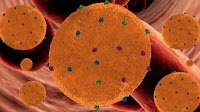 Sometimes it is rocket science and other times it isn’t. How to get rid of toxic stuff in the blood? Suck it up using nanosponges. Scientists at the University of California in San Diego have made tiny sponges—so small about 3000 can fit into a blood cell. These nanosponges suck up molecules that are toxic because they form pores membranes. Bacteria like E. coli and Staphylococcus produce these toxin and disease like toxic shock syndrome. A bit too soon to get a nanosponge treatment but the idea is exciting.
Sometimes it is rocket science and other times it isn’t. How to get rid of toxic stuff in the blood? Suck it up using nanosponges. Scientists at the University of California in San Diego have made tiny sponges—so small about 3000 can fit into a blood cell. These nanosponges suck up molecules that are toxic because they form pores membranes. Bacteria like E. coli and Staphylococcus produce these toxin and disease like toxic shock syndrome. A bit too soon to get a nanosponge treatment but the idea is exciting.
Read more or for all the details here
